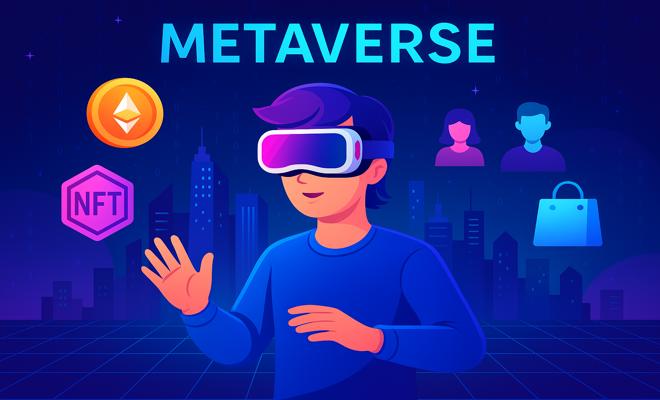
The Metaverse: Hype or the Future of Digital Reality?
📌 Introduction
In recent years, the term Metaverse has moved beyond science fiction into mainstream conversations, attracting billions in investments from tech giants 💼. But what exactly is the metaverse, and is it merely hype—or a transformative shift in how humans will interact, work, and live in the digital world? 🌐
🌍 What Is the Metaverse?
The metaverse is a shared virtual universe created by merging physical reality with digital experiences. Think of it as the next version of the internet—immersive, interactive, and persistent 🧠💻.
It combines:
- Virtual Reality (VR) 🥽
- Augmented Reality (AR) 📱
- 3D avatars 🧍♂️🧍♀️
- Blockchain-based assets like NFTs 🧾
- Social and gaming platforms 🎮👾
The concept first appeared in Neal Stephenson’s Snow Crash (1992), but it exploded into public discourse when Facebook rebranded as Meta in 2021.
💰 Economic Potential and Industry Investment
The metaverse could become an $800 billion industry by 2030 🚀. Companies like Meta, Microsoft, Apple, and Nvidia are investing in virtual worlds, digital goods, and immersive technology.
Some major developments include:
- Virtual real estate 🏠 sold as NFTs on platforms like Decentraland and The Sandbox
- Brands like Nike 👟 and Gucci 👜 opening digital stores
- Virtual concerts and experiences from artists like Ariana Grande 🎤
👩💻 Work and 📚 Education in the Metaverse
Imagine attending meetings in a 3D office or studying at a virtual university from your bedroom. That’s the vision of platforms like Microsoft Mesh and Meta’s Horizon Workrooms.
Benefits:
- Enhanced collaboration 🧑🤝🧑
- More engaging learning environments 🎓
- Global access to experiences 🌎
Challenges:
- Cost of VR hardware 💸
- Digital fatigue 😓
- Internet speed and accessibility 🚫📶
👥 Social Life & Digital Identity
In the metaverse, users can create avatars 🧍, hang out with friends 👯, go on virtual dates 💘, or attend events 🎉. But this also raises questions:
- Who owns your data? 🔐
- What if your avatar is harassed? 🚫
- Can you protect your virtual property? 🛡️
Blockchain helps with ownership (e.g., NFT-based clothes 👗), but digital ethics and security still need work.
⚠️ Challenges and Criticism
While exciting, the metaverse isn't without flaws:
- Accessibility: VR headsets are expensive 💰
- Privacy concerns: More tracking, less control 🕵️
- Lack of regulations: Legal grey areas ⚖️
- Mental health: Escapism and addiction risks 🧠🧨
Critics say it’s just an overhyped version of Second Life or MMORPGs. Without real value, it could fade out as quickly as it rose.
🔭 The Future Outlook
The metaverse is evolving. As tech improves—AI 🤖, 5G 📡, and haptics 🧤—it will become more realistic and accessible.
Potential long-term impacts:
- 🛍️ Shopping in virtual malls
- 🏥 Remote healthcare with immersive diagnostics
- 🌆 Virtual tourism and cultural experiences
- 🗳️ Digital governance and smart cities
But its future depends on open development, inclusivity, and ethical innovation.
✅ Conclusion
The metaverse is more than a tech trend—it’s a digital evolution 🌱. While still in its early stages, it has the power to reshape how we live, work, and connect. Whether it thrives or collapses depends on how we address its social, technical, and economic challenges.
One thing is certain: the future is being built in the metaverse. 🔧🌌